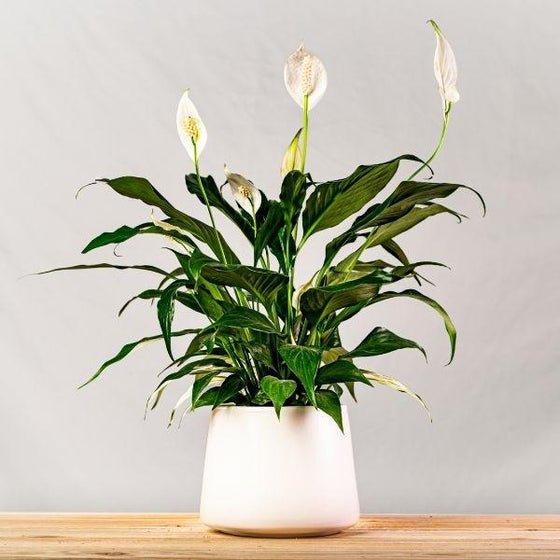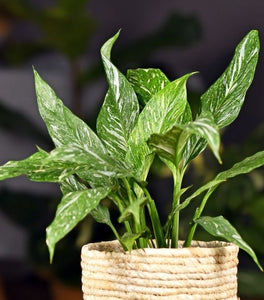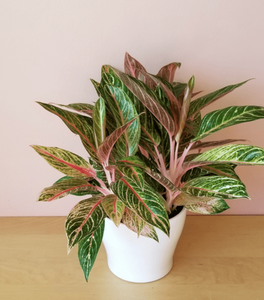
Images Depicted Range in Maturity & Container Size
Pots & Decorations Not Included Unless Otherwise Stated
Lush, Elegant Foliage with Beautiful White Blooms — Indoors, All Year Long
Classic Beauty That Fits Every Interior
The Peace Lily is one of the most iconic indoor plants of all time, known for its glossy, deep-green leaves and graceful white blooms that appear multiple times a year. The blooms rise above the foliage like white flags of tranquility, giving the plant its peaceful name.
Its soft, sculptural form adds calm energy to bedrooms, living spaces, offices, and entryways. Peace lilies work well in every interior style — modern, traditional, minimalist, and tropical — making them one of the most universally decorative houseplants available.
A Natural Air Purifier for Healthier Indoor Spaces
Peace Lily isn’t just beautiful — it’s also one of NASA’s top-rated air-purifying plants, helping filter common indoor pollutants from the air. It gently increases humidity, making indoor spaces feel fresher and more comfortable, especially during dry winter months or in rooms with constant HVAC airflow.
This makes Peace Lily ideal for bedrooms, workplace desks, home offices, bathrooms, hallways, and cozy corners where you want the air to feel lighter and cleaner.
Thrives in Low and Moderate Light
Unlike many flowering plants that require bright light or direct sun, Peace Lily grows perfectly in shaded or indirect light settings. It maintains full foliage even in dimmer areas where other houseplants fade.
While it can thrive in low light, placing it in bright, indirect light encourages more frequent blooms and deeper, richer leaf color — giving you the best of both performance and beauty.
Low-Maintenance and Beginner-Friendly
Peace Lily is famous for being easy to read — its leaves gently droop when it needs water and perk up again soon after watering. This makes it a comforting, forgiving choice for new plant owners learning watering rhythm.
Once established, it becomes a steady, resilient, glowing presence in your home — lush, full, and continually renewing itself.

| Hardiness Zone: | 10-12 Outdoors |
|---|---|
| Mature Height: | 24 - 36 inches |
| Mature Width: | 1 to 3 feet |
| Classification: | Indoor Houseplant |
| Sunlight: | Low to Medium Indirect Light |
| Habit: | Upright |
| Flower Color: | White |
| Foliage: | Green, glossy |
| Soil Condition: | Well-draining indoor potting mix |
| Water Requirements: | Keep soil lightly moist; avoid standing water |
| Uses: | Adapts to variable light; responds well to neglect. bedrooms, office styling, gift plant |
How to Care for Peace Lily (Spathiphyllum)
Once you buy a Peace Lily plant, make sure to read about the recommended care instructions to keep this plant healthy and thriving.

How should I plant Peace Lily?
Use a pot with drainage holes and fill it with well-draining indoor potting mix. Loosen the roots before planting and position the crown at soil level. After repotting, water gently to settle the soil. Place Peace Lily in low to medium indirect light — bright enough to read by but not in direct sun. It does not require a window seat to thrive, making it ideal for apartments and offices.
How often should I water Peace Lily?
Water when the top inch of soil feels dry. Peace Lily likes consistent moisture but should never sit in standing water. When thirsty, its leaves will gently droop — a natural, reversible signal. Increase humidity using a pebble tray or misting in dry rooms. If tips brown, increase humidity or soften tap water if your water is mineral-heavy.
When should I fertilize Peace Lily?
Feed once every 4–6 weeks during spring and summer using a diluted liquid houseplant fertilizer. Light feeding helps encourage more blooms. Reduce feeding in fall and winter when growth naturally slows.

When and how should I prune Peace Lily?
Remove yellowing or old leaves at the base as needed. After blooms fade, trim the spent bloom stalk near the soil. Rotating your plant weekly encourages balanced growth and keeps the foliage full and symmetrical.
















